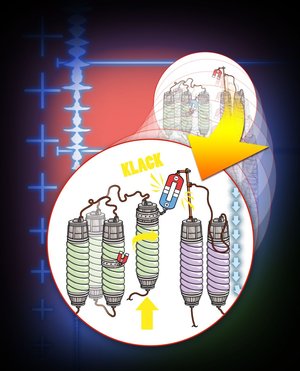Mutations in the voltage-gated sodium channel Nav1.7 are known to be linked to the inherited pain syndrome Erythromelalgia. The majority of these mutations produce a prominent shift of their activation voltage to more hyperpolarized potentials, rendering the expressing neurons hyperexcitable. In our study „Erythromelalgia Mutation Q875E Stabilizes The Activated State Of Sodium Channel Nav1.7“ we describe how the Q875E mutation most likely introduces a new salt bridge, which traps the voltage-sensor of Nav1.7 in the open conformation. This trapping mechanism was previously only described for animal neurotoxins that act on sodium channels but we now show that this mode of action may also arise in a naturally-occurring pain-linked mutation.
Stadler T.S., A.O. O’Reilly, A. Lampert. “Erythromelalgia Mutation Q875E Stabilizes The Activated State Of Sodium Channel Nav1.7” Journal of Biological Chemistry; in press.
<link http: www.ncbi.nlm.nih.gov pubmed>
www.ncbi.nlm.nih.gov/pubmed/25575597
For an artistic representation of the main findings of this paper please see <link file:11301 download herunterladen der datei>here.
<link file:11301>
© Kilian Wilde

![[Translate to en:] [Translate to en:]](/fileadmin/files/institute/physiologie/_processed_/9/6/csm__ME18759_4dcd3c7cfd.jpg)
![[Translate to en:] [Translate to en:]](/fileadmin/files/institute/physiologie/_processed_/4/6/csm__ME18836_e9746e1c31.jpg)
![[Translate to en:] [Translate to en:]](/fileadmin/files/institute/physiologie/_processed_/d/e/csm__ME18866_8e2719aa71.jpg)
![[Translate to en:] [Translate to en:]](/fileadmin/files/institute/physiologie/_processed_/b/6/csm__ME18941_58dbfb528e.jpg)
![[Translate to en:] [Translate to en:]](/fileadmin/files/institute/physiologie/_processed_/0/7/csm__ME18965h_2b5a133f2a.jpg)
![[Translate to en:] [Translate to en:]](/fileadmin/files/institute/physiologie/_processed_/a/5/csm__ME18992_688dd41c10.jpg)
![[Translate to en:] [Translate to en:]](/fileadmin/files/institute/physiologie/_processed_/1/1/csm__ME19185_8a61b218cf.jpg)
![[Translate to en:] [Translate to en:]](/fileadmin/files/institute/physiologie/_processed_/7/5/csm__ME27611_14f178eb7a.jpg)